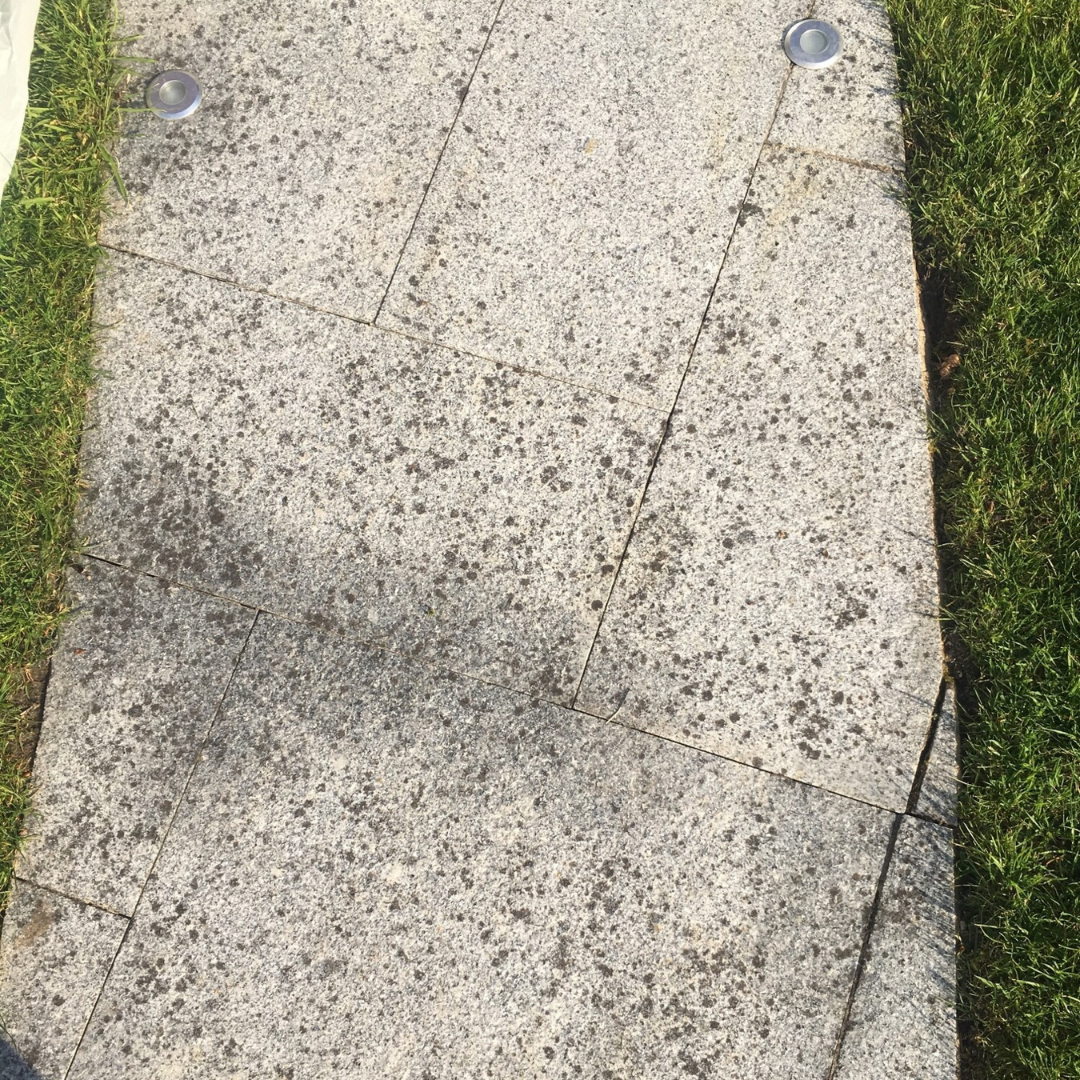If your patio has developed black marks which you are struggling to remove, the probability is that your patio is suffering from Black Spot.
In which case, you need: Rob Parker’s Best Patio Cleaner
Read this blog to understand what Black Spot is and the best way to remove it:
What is Black Spot?
Black Spot is a lichen which thrives on stone surfaces in the damp and shady conditions that are so common in the UK. The characteristics of the lichen are that as it matures, it sends out tendrils (hyphae) into the pores of the stone seeking nutrients from the minerals in the stone and the detritus that collects on the patio. These gradually spread through the surface of the affected stone like fine roots. The hyphae are an anchoring system for the black spot visible on the surface of the stone. This in part is what makes this problem so difficult to remove, as many cleaners only deal with the surface issue. To effectively remove black spot in the long-term, the hyphae have to be destroyed, which in turn will enable the surface black spots to be removed by manual brushing or power washing after treatment.

Which stones are worst affected by Black Spot?
Black Spot is a bigger problem on stones that have larger pores as part of its structure because they offer the ideal surface for the hyphae to spread. Therefore, Black Spot does not generally occur on Indian limestone because the structure of the stone is very close grained and there is no opportunity for detritus to collect on the surface. Typical Indian limestones that would be in this group are Kota Brown, Kota Blue, Black Limestone & Tundra Limestone. Conversely, sandstone has a much more open texture with larger pores and is therefore much more likely to be affected by Black Spot.
However, there is a hierarchy within the Indian sandstones, whereby some colours are more affected than others. For instance, the better-quality Raj Green is one of the densest, close textured sandstones available, and therefore, because of its structure, will not be affected.
However, as you move through the colour range of the Indian Sandstones from dark to light, the occurrence of Black Spot becomes more prevalent:
Black Sandstone – Slightly Affected
Kandla Grey
Modak
Mellow Yellow
Fossil Mint – Highly Affected
Fossil Mint, one of the most popular Indian sandstones, has the lightest colour and the largest pores, so it is the stone surface that is going to have the worst incidence of Black Spot, particularly if the stone is laid in damp, shady conditions with lots of surrounding plant growth.
Will pressure washing remove it from my patio?
During the first 2 years after a stone surface has been laid, any Black Spot growth will appear to be simply a surface problem that can be successfully removed by power washing. However, this is not removing or killing the spreading hyphae that are within the stone surface. Over an extended period, the hyphae, now well-established within the stone surface creates an anchor for the black spot to colonise the stone surface which will become increasingly blackened, and more difficult to clean away.
If pressure washing is not effective, what other options are there for removing it from my patio?
The use of a high temperature, low pressure steam cleaner (such as Doff) will kill the black spot but won’t always remove the more stubborn black marks on the stone unfortunately (dead but not removed!).
What is the most effective way of removing Black Spot from my patio?
A far more effective way of killing and removing black spot, is to use a product like Rob Parker’s Best Patio Cleaner, which has been developed by scientists after researching the best way to kill the lichen to prevent new growth, and also remove the existing marks.
Rob Parker’s Best Patio Cleaner is a biocide which will get into the growth and kill the Black Spot permanently, but also has a bleaching agent which will bleach the blackness out of the visible Black Spot.
To work properly it is necessary to ensure that the product remains on the affected stone for at least an hour (but up to 24 hours) and that during the treatment period the stone surface remains wet.
After treatment the biocide will have killed all the Black Spot spores, preventing new growth from occurring in the future. Most of the remaining dead black spot deposits will not be visible as the chlorine content will have bleached them. Sometimes, particularly stubborn deposits will remain on the stone after treatment.
Rest assured, that over time, now that there is no live lichen in the stone, these (bleached) dead deposits will loosen, and the next time the patio is power washed, any remaining lichen deposits will be removed, and the stone surface will become as clean and brilliant as it was when first laid.
